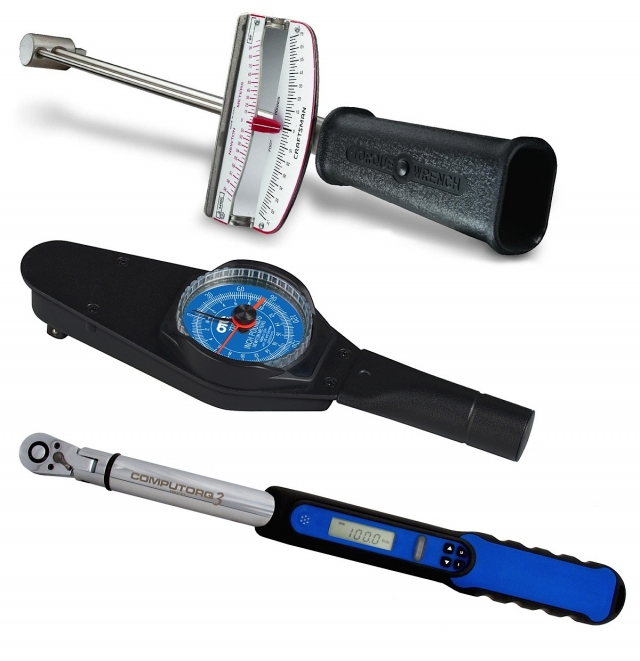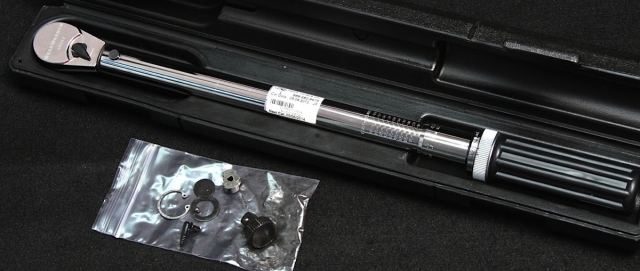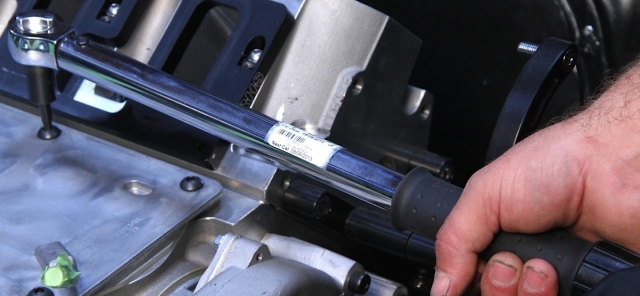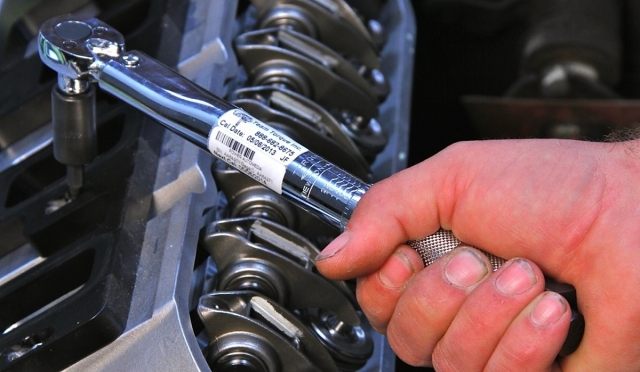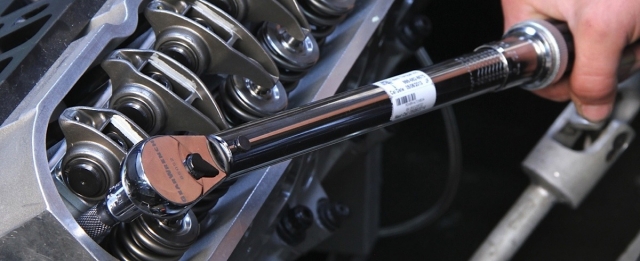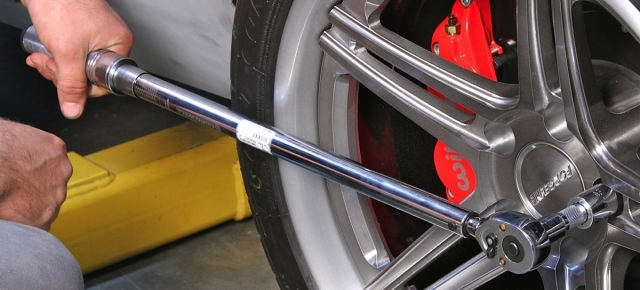 When it comes to an engine, all fasteners are not created equal—some bolts are justifiably more important than others. Connecting rod and main bearing bolts have a more critical job than, say, valve cover bolts. Hence, they need more consideration during engine assembly, and that focused attention is charged to the torque wrench.
When it comes to an engine, all fasteners are not created equal—some bolts are justifiably more important than others. Connecting rod and main bearing bolts have a more critical job than, say, valve cover bolts. Hence, they need more consideration during engine assembly, and that focused attention is charged to the torque wrench.
Engine designers and hardware engineers determine how much of a clamping load each fastener should have, based on its responsibility to hold components together. The only way to make sure you’re putting the correct load into each one is to use a properly calibrated torque wrench when installing the fastener. Note the operative words: properly calibrated.
A torque wrench is arguably the most essential tool in an engine builder’s toolbox, but it can also betray its master. The torque wrench indicates to the engine builder the amount of twisting force or torque being applied to the fastener. Knowing this force is necessary. Not enough and the bolt won’t have the proper tension to keep it tight, and too much force can overly stretch and break the fastener. This function is universally understood about torque wrenches, but many mechanics don’t realize that age, use, abuse and many other factors can render even the best torque wrench out of calibration. When it does, the problems just mentioned can arise. For this reason, every torque wrench should be sent out for routine calibration.
“Technicians generally send a torque wrench in when something is broken, then are surprised to learn tool isn’t in calibration,” says Rich Sabot, lab manager at TeamTorque, one of the nation’s leading torque wrench repair and calibration shops. “If a torque wrench is used consistently it will tend to fade. If it is used improperly it could go away in a hurry.”
Types of torque wrenches
As it is a precision instrument, a torque wrench should be treated as such. Think of it in the same category as an expensive micrometer set—there are right and wrong ways to use a torque wrench for accurate readings, and ways of damaging it if you’re not careful. Those tips and tricks will be discussed later; but here’s an overview on the different types of wrenches.
Beam-type–The beam-style was formerly the most common style of torque wrench. As you tighten the fastener, a beam in the wrench head bends against the force and registers on a scale, kind of like how a fish scale works but much more accurate. In fact, these old-school wrenches are fairly accurate even by today’s standards. They are also good for seeing the torque values throughout operation, like when setting up a differential or determining piston-ring tension. Their disadvantages are that they require more attention during use (you need to look at them from the right angle), and there is no adjustment, so when they get old there’s nothing you can do to bring them back into calibration. Hence, in the trash they should go.
Dial-type–A dial wrench is actually a modified version of a beam-style, but instead of the beam it uses a dial with a movement, like a watch. The benefit to this wrench is that if it falls out of calibration, you can adjust the dial back into spec.
The great majority tools we see are out of calibration. — Rich Sabot, Team Torque
Click-type–The majority of torque wrenches in automotive use today are the click style. Adjusting a mechanism in the handle sets the target torque figure, and when the target is reached while applying torque to the fastener, the wrench will make an audible click, indicating the selected torque value. There are many ways that manufacturers use to produce that click, some simple and some complicated, but all styles will eventually fall out of calibration. Generally speaking, click-type torque wrenches have an accuracy rating off 4 percent clockwise, 6 percent counter-clockwise.
Digital–It’s a digital world now, so there’s little wonder that digital torque wrenches are gaining in popularity. A digital wrench is somewhat similar to a beam style but the readings are derived by measuring forces applied to a strain gauge attached to the beam. The electronic data is then analyzed through a small computer processor and displayed on a digital readout. Typically, digital wrenches are more precise with one percent accuracy in both directions. When calibrating them, they need to be connected to a computer to access the wrench’s software.
Team Torque To The Rescue
The Power Automedia editors and shop techs collectively have several torque wrenches among them, and the challenge was issued to see how accurate some of them were. A sampling of five wrenches was gathered and shipped to Team Torque in Bismarck, North Dakota, for testing and calibration. The results were interesting to say the least and are discussed later in this story.
Right or Wrong?
To grab the socket or not, that’s the big debate. While it feels natural to steady the torque wrench at the ratchet head or socket, there’s also conventional wisdom that feels such a practice can affect the reading. When Team Torque tests wrenches, the only human contact is on the handle — there is no support at the head of the wrench. So, make up your own mind.
Team Torque was founded by Mark Anderson, who was working as a farmer and one day broke a torque wrench. He sent it off to an authorized service center for repair, and when it took four weeks to get back, he just knew there was a better way. The company’s turnaround time is typically three days, proving him right.
“Our point of pride is our speed. One of the ways we do that is that we keep a large stock of parts on hand,” says Sabot.
A routine analysis starts when a customer’s wrench is received and necessary information is entered into the company proprietary computerized tracking system that follows the tool throughout the process. The software has numerous resources, like schematics, pricing, invoicing and replacement part numbers. Every tool sits in the temperature- and humidity-controlled lab for a prescribed time to “acclimate,” which is especially important in the oft-cold climate of North Dakota.
“If it’s freezing outside we don’t work on the tool right as it comes in from the cold. We let it reach room temperature,” explains Sabot.
After verifying the wrench, a technician will verify its functionality by checking the ratchet mechanism and inspecting the teeth.
“A common malfunction on a tool is a stripped ratchet,” says Sabot. “It has nothing to do with calibration of the tool, but it’s more of a safety thing.”

Shown are the reports received from Team Torque. The crucial information for each wrench is reviewed below.
Any bad ratchets are replaced as part of Team Torque’s service. Then the wrench goes on a torque tester, which also has a serial number and an extensive history record that includes the the weights and arms used to calibrate all test equipment. In fact, all the test weights are numbered and often compared to national standard weights to ensure accuracy. For the initial test readings, each wrench is tested at 20, 60, and 100 percent of its full scale.
“By using those initial readings, we can determine what’s going on with the tool,” explains Sabot. “It gives us a good baseline as to what we need to do with the tool to adjust it into calibration. The great majority tools we see are out of calibration.”
Testing is done by hand on all but the biggest wrenches. Click wrenches that test up to 3,000 pounds can be up to six feet long and require three technicians to pull during a test. The hand testing is done primarily because it’s faster, but also because that’s how engine builders and other mechanics will use them.
“We have done tests comparing between mechanical and manual loading, and the difference is negligible,” affirms Sabot. “We also do intra-lab comparisons, comparing our numbers to another lab across country.”
With the readings in hand, the technicians calibrate the wrenches back into specification. That could mean adjusting the handles, disassembling the wrench to make adjustments inside, swapping pieces, and so on, based on their experience. After the tool is calibrated, it is tested again on a digital torque tester at 20, 60 and 100 percent of the wrench’s range; although, Team Torque sometimes adds tests at 40 and 80 percent. Technicians pull 15 readings and averaging the results for better accuracy. The digital tester captures and sends readings to the computer, eliminating any human errors from the data-gathering process. At this point, a calibration label with the serial number and date is printed and applied to the tool. The computer also crunches the numbers for the tool’s certificate before the wrench is packaged and returned to the customer.
See, you never knew your torque wrench needed so much love, did you?
So What Did We Find Out?
EngineLabs sent Team Torque five wrenches to undergo testing/calibration. Four were found in the Power Automedia shop and editor’s toolbox. Another new wrench found in the bottom of another editor’s desk was tossed into the mix just to see how an unwrapped product would fare in the test. All the wrenches were click type, as none of technicians or editors had another style.
Turnaround time by TeamTorque was as promised, and the wrenches were returned in better packaging that we used to send them. One wrench needed repair, and the old parts were returned. One wrench, ironically the new one that was sent still in the package, was condemned! It was a 3/8-drive with a range of 120-960 in-lb and sold under the brand of Performance Tool. The initial tests proved to be so far off that Team Torque determined it wasn’t worth fixing or calibrating and suggested destroying it. The other four were calibrated and a full report was sent. Following are individual reports for each of four calibrated wrenches. At the end of this story you’ll find a number of tips and tricks pulled from a variety of sources to help ensure torque wrench care, maintenance and use.
Craftsman 3/8-drive, 5-80 ft-lb
Description: This wrench was used moderately in the mid-90s, mostly torquing wheels and easy engine work like intake manifolds. It had been in the bottom of the owner’s tool box for almost 20 years.
Verdict: Tool was out of calibration and/or needed parts. Adjusted and/or repaired tool and calibrated to specifications listed below.
Generic 1/4-drive 2-24 Nm
Description: The shop foreman bought this wrench three years ago at an auto parts store for general use. When looking closely at it, we discovered that it is identical to the “new” Perfomance Tool wrench. Hence, probably both were private labeled from the same company.
Verdict: Tool was within tolerance. Calibrated and certified to specifications below.
Gearwrench 3/8-drive 10-100 ft-lb
Description: This has been in the shop foreman’s box for a number of years and used regularly.
Verdict: Tool was out of calibration and/or needed parts. Adjusted and/or repaired tool and calibrated to specifications listed below.
Cornwell ½-drive 30-250 ft-lb
Description: This one has been heavily used and abused in the PAM shop for five years.
Verdict: Tool was within tolerance. Calibrated and certified to specifications below.
Torque Wrench Tips & Tricks
- Always back a click-type torque wrench down to its lowest setting when not in use. There is a compression spring inside, and as you turn the handle to raise the torque setting, it applies more pressure to the spring to operate the click mechanism. If you leave it there, that spring will stay fully compressed and gradually lose its spring factor. Returning the wrench to the lowest setting will release that pressure. And make sure to store it in its protective case.
- Do not exceed the torque wrench’s recommended range of operation. Generally, most mechanical wrenches have a usable range from 20-100 percent of full scale, and digital wrenches can be reliable from 10-100 percent. Sabot recommends never trusting numbers below 20 percent.”
- Don’t drop a torque wrench or otherwise beat it up, as that kind of abuse can very likely throw it out of calibration. If you suspect a torque wrench has been dropped, send it in to be checked and/or repaired.
- Avoid exposure of the wrench to extreme temperatures, humidity, corrosive environments…basically anything that makes you uncomfortable also makes your torque wrench uncomfortable.
- Avoid the temptation to etch your name into a torque wrench handle.
- Don’t use a torque wrench to remove fasteners. It should only be used to torque a fastener to a specific setting.
- Always grab the torque wrench in the middle of the handle grip, as every wrench is calibrated for accurate readings at a specific handle length. Also, don’t put your other hand on the head of the wrench—only grab the handle if possible.
- Pull perpendicular to the tube of the wrench with a smooth motion. Don’t jerk it at all.
- Always pull on a torque wrench, don’t push it.
- Team Torque tests wrenches at chest height with the wrench parallel to the floor, so you should use it that way if possible.
- When the wrench signals that the torque value has been reached (by clicking, beeping, or with lights), stop pulling it.
- There is lubrication in a click-type torque wrench and it will gum up over time, but don’t try to re-lube a torque wrench by taking it apart, since small parts will likely go flying unless you know what you’re doing.
- Many people think that socket extensions can affect readings, but Sabot says they really won’t until the extension length gets extreme. Still, if you don’t have to use an extension, it’s probably best to avoid.




